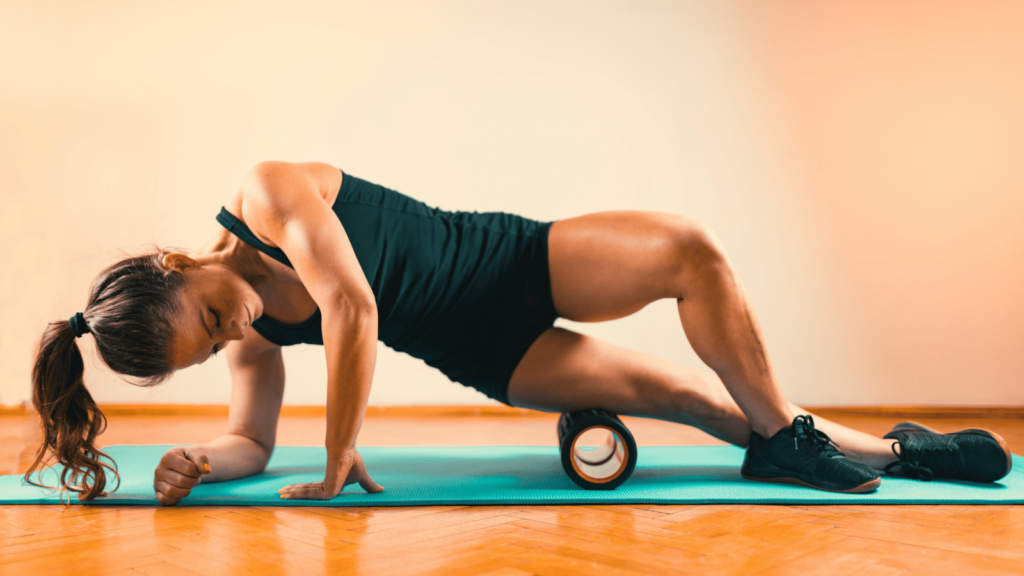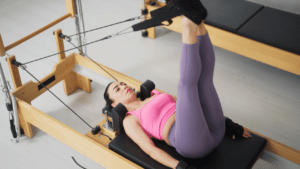
The humble foam roller, with its lightweight and simple design, is undoubtedly one of the most approachable pieces of equipment in the gym. However, it still holds an air of mystery and intimidation, leaving many questioning its purpose and proper usage. Now is your chance to get to know a bit more about this unassuming recovery tool and why athletes should be using a foam roller regularly. Whether you’re a pro athlete or an occasional gym-goer, foam rolling is one of the most accessible and effective ways to massage muscles, reduce tension, and even improve athletic performance. So why not seize the opportunity to explore the potential benefits and see if it can help you reach your fitness goals?
What is a Foam Roller?
Simply put, a foam roller is a cylindrical device made of dense foam, primarily used in a technique known as self-myofascial release (SMR). Fascia is the connective tissue surrounding your muscles, and sometimes, it can get a bit stiff or form knots, which can affect your performance. That’s where the foam roller comes in.
How Does a Foam Roller Work?
The effectiveness of foam rolling lies in its impact on the fascia, a web of connective tissue that surrounds muscles and organs. Fascia plays a crucial role in maintaining the structural integrity of the body and providing support to the muscles. When muscles are overused or injured, the fascia can become tight and restricted, leading to pain and reduced range of motion.
During foam rolling, the pressure applied to the muscles and fascia helps break up adhesions, which are areas of stuck-together tissue. These adhesions can restrict movement and cause discomfort. By breaking them up, foam rolling allows for greater mobility and flexibility.
How Foam Rolling Works on Muscle Recovery
But it’s more than just that fascia. Mechanoreceptors, the sensors that respond to physical force in our bodies, play a pivotal role in foam rolling, too. These receptors send a signal to the brain indicating significant tension on the muscle, prompting the central nervous system to relax the muscle and prevent tearing. This, in turn, results in reduced muscle tension, alleviated pain, and improved blood flow. Increased blood flow plays a crucial role in minimizing post-workout soreness, making it the primary mechanism at work.
But foam rolling doesn’t stop there. It also supports lymphatic and blood circulation, which helps helps your muscles receive oxygen and nutrients. This accelerated blood flow also aids in the removal of toxins and waste from the muscles, hastening recovery and lowering inflammation. This anti-inflammatory effect helps athletes better manage pain and discomfort while also promoting muscle recovery.
Other Benefits of Foam Rolling for Athletes
Foam rolling is not just about dealing with muscle soreness, but it’s also a proactive strategy that can aid in better performance, increased mobility, and general wellbeing. Here’s a more comprehensive look:
Increases Circulation
Foam rolling exercises help improve blood circulation throughout the skin, fascia, muscles, and even tendons and ligaments. Improved blood circulation means more oxygen and nutrients are delivered to these areas, promoting faster and more efficient recovery after workouts. Additionally, better circulation can help flush out toxins from your body, contributing to overall health.
Improves Mobility and Flexibility
Regular foam rolling has been found to significantly increase joint range of motion. By working out the knots in your muscles, you can help restore them to their original length, improving mobility and flexibility. Moreover, increased flexibility is associated with better performance in physical activities and a lower risk of injuries.
Reduces Muscle Soreness and Speeds Up Recovery
According to research, foam rolling can lessen the intensity of delayed-onset muscle soreness (DOMS), those aches that can develop 24 to 48 hours after strenuous exercise. This is especially beneficial after a high-intensity workout, as it helps to speed up recovery. Ideal for quick recovery from a hard leg day. The practice allows for more frequent training, as the recovery time is shortened, leading to more effective workouts.
Promotes Relaxation and Stress Relief
Just like a massage, foam rolling stimulates the parasympathetic nervous system, which is responsible for relaxation and recovery. Regular self-myofascial release can help reduce stress levels, which can improve mood and overall quality of life. It’s a form of self-care that can easily be incorporated into your daily routine.
Prevents Injuries
Regular use of foam rollers for pre-workout and post-workout massage can prevent injuries. It helps to increase blood flow and oxygen to the tissue, improving mobility and flexibility and decreasing the chance of injury.
How to Choose a Foam Roller
Your choice will depend on several factors, including your comfort level with deep tissue massage, your fitness level, and specific needs or issues you’re trying to address.
Density
One of the most critical factors is the foam roller’s density or firmness. If the roller is too soft, you may not get a sufficient massage. If it’s too hard, the pressure could be uncomfortable or painful. Foam rollers come in soft, medium, and hard densities.
- Soft: Soft foam rollers have more give and are ideal for beginners or those with a low pain tolerance. They’re less intense, which can be beneficial if you’re just starting or if you’re using them for recovery.
- Medium: The medium offer a balance between comfort and effective muscle massage. They’re firm enough to target muscle knots but soft enough to be comfortable.
- Hard: Hard foam rollers are best for serious athletes or individuals who prefer deep-tissue massages. They are very dense and don’t have much give.
Size
Foam rollers also come in various lengths and diameters.
- Long (36 inches): This size is perfect for larger muscle groups like the back, and it is also stable enough for beginners. It can be used for both upper and lower body work.
- Medium (24 inches): This size is versatile and portable. It’s good for many exercises and easy to carry, making it great for traveling.
- Short (12 inches or less): This size is ideal for single-arm and single-leg work. It’s also excellent for targeting smaller areas like the arms and calves. It’s the most portable size.
Surface Texture
Foam rollers can have a smooth or textured surface.
Smooth: Smooth foam rollers provide even pressure across the entire length. They’re ideal for beginners or for those who prefer a gentle massage.
Textured: Textured foam rollers have ridges, bumps, or other patterns. The texture allows for varying pressure levels and can mimic the feeling of a masseuse’s hands for a more intense, targeted massage.
Vibrating Foam Rollers
This type is a newer variant and combines traditional foam rolling with vibration technology. These rollers offer different vibration settings and can provide a more intense massage that reaches deeper muscle layers.
Tips on How to Use a Foam Roller
Now we understand why foam rolling is creating such a buzz, let’s dive into the world of foam rolling. Here are some essential tips for beginners on how to effectively utilize a foam roller:
- Position the Foam Roller: Begin by sitting or lying down on the floor and position the foam roller under the muscle group you wish to target. Your body weight will apply the pressure, so the more of it you put on the foam roller, the deeper the pressure will be.
- Roll Slowly: Once positioned, slowly roll your body back and forth over the roller. Move slowly and spend a few seconds on each ‘inch’ of the muscle. If you encounter a particularly painful or tight spot (often referred to as a ‘trigger point’ or ‘knot’), try to hold your position on this spot for a few seconds to help release it.
- Don’t Overdo It: Roll each muscle group for about 30 seconds to one minute. Don’t overdo it, as excessive rolling could lead to discomfort or even bruising. Also, avoid rolling directly on joints or bones.
- Breathe: It may be tempting to hold your breath, but try to breathe normally. Breathing helps your muscles relax and increases the effectiveness of the rolling.
- Hydrate: Remember to hydrate after a session of foam rolling, just as you would after any other exercise session. This will help flush out the toxins released during the rolling process.
- Listen to Your Body: Foam rolling may be uncomfortable, but it shouldn’t be excruciating. If you find it unbearable, you might be applying too much pressure, or there may be a more serious issue at hand, such as an injury that requires medical attention.
- Consistency is Key: As with most exercise practices, consistency is key. Regular foam rolling, before or after workouts or even on recovery days, can help maintain muscle health and improve performance over time.
- Combine Foam Rolling with Stretching: Pairing foam rolling with static or dynamic stretching can further enhance flexibility and range of motion.
Remember, foam rolling may feel slightly uncomfortable, particularly when you first start or if you’re working on a tight or sore muscle, but it should never be unbearable. If it’s too painful, try using a softer roller or applying less body weight. Always consult a healthcare provider before beginning any new exercise regimen, including foam rolling, especially if you have any chronic health conditions or injuries.
Make the Foam Roller Work For You
Now that you’ve delved into the mechanics of how foam rollers work, you’re likely motivated to give this simple tool a shot and incorporate it into your recovery routine. By harnessing the power of the foam roller, you’re not just rubbing out muscle knots, but activating mechanoreceptors, stimulating lymph and blood circulation, and even nurturing your fascia. It’s clear that this straightforward fitness accessory can punch above its weight, offering you benefits that can propel your athletic performance and recovery to new heights. So, why not roll into your next workout armed with a better understanding and readiness to reap the benefits of a foam roller?
Follow up foam rolling with some muscle scraping for a one-two punch.



